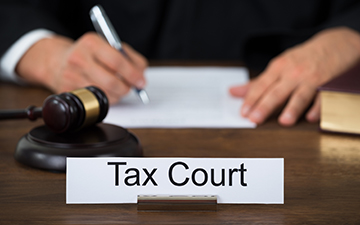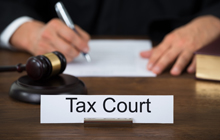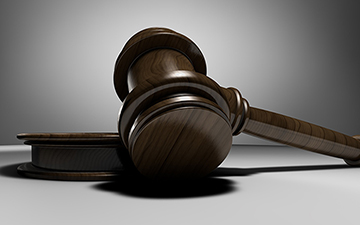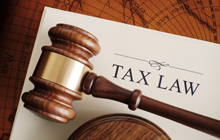Tax Court orders CRA to release GAAR committee reports about similarly situated taxpayers

Canadian accountant and tax lawyer David J Rotfleisch explains why the Committee's legal analysis fell within within the scope of discovery
Editor's note: Coopers Park Real Estate Development Corporation is a subsidiary of Coopers Park Corporation. The company, which is based in B.C., invests in multi-family residential condominium developments and in the information technology sector. In 2012, Coopers Park announced it had been reassessed and had engaged legal counsel. It was represented in court by KPMG Law.
Introduction: The general anti-avoidance rule and documentary discovery during tax litigation
 |
David J Rotfleisch, CPA, JD is the founding tax lawyer of Taxpage.com and Rotfleisch & Samulovitch P.C., a Toronto-based boutique tax law corporate law firm. |
Section 245 of Canada's Income Tax Act contains the general anti-avoidance rule (GAAR). The GAAR aims to prevent taxpayers from enjoying tax benefits by invoking avoidance transactions that misuse or abuse specific provisions of the Income Tax Act. In particular, the rule gives the Canada Revenue Agency the power to deny a tax benefit-i.e., tax reduction, tax avoidance, or tax deferral-arising from an abusive avoidance transaction or from a series of transactions that included an abusive avoidance transaction.
In a tax dispute involving the GAAR, the CRA bears the burden of proving that a transaction resulted in abusive tax avoidance. To do so, the Canada Revenue Agency must establish that the resulting tax benefit would contravene the purpose of the income-tax provision that the taxpayer relied upon when invoking the avoidance transaction. Hence, the GAAR effectively permits the CRA to look past the text of the Income Tax Act and ask whether the transaction offended a tax rule's purpose.
The GAAR therefore has the potential to undermine certainty for taxpayers attempting to plan their affairs. The rule asks not whether a transaction satisfied the concrete language describing the impugned tax rule, but whether the transaction violated the tax rule's unwritten purpose. As a result, Canadian courts, the Minister of National Revenue, and the Canada Revenue Agency all understand the importance of applying the GAAR consistently. To this end, the CRA has established a GAAR Committee, which consists of officials from the Canada Revenue Agency, the Department of Finance, and the Department of Justice. The GAAR Committee reviews all files where the GAAR might apply-including taxpayer requests for advance rulings and referrals from the CRA's Audit Division — and decides whether to issue a GAAR-based ruling or reassessment.
The Canada Revenue Agency had previously concealed the details of the GAAR Committee's proceedings. These details would, of course, benefit taxpayers facing GAAR-based reassessments. In Coopers Park Real Estate Development Corporation v. The Queen, the Tax Court of Canada ordered that, during the discovery process in tax litigation involving a GAAR-based assessment, the CRA must release GAAR Committee details not only about the appellant taxpayer but also about similarly situated taxpayers. This decision means that a taxpayer's Canadian tax-litigation lawyer may now obtain GAAR Committee details that had previously been inaccessible. (Of course, there are certain limits. For example, the decision doesn't compel the CRA to release privileged documents.)
After discussing both the general anti-avoidance rule and the discovery process in tax litigation, this article examines the Tax Court's decision in Coopers Park. We conclude the article by offering pro tax tips from our expert Canadian tax-litigation lawyers.
GAAR: Section 245 of Canada's Income Tax Act
Section 245 of Canada's Income Tax Act contain the provisions relating to the general anti-avoidance rule (also known as the "GAAR"). These provisions allow the CRA to deny a tax benefit — i.e., tax reduction, tax avoidance, or tax deferral-arising from an abusive avoidance transaction or from a series of transactions that included an abusive avoidance transaction.
The Income Tax Act contains many specific anti-avoidance rules. These rules preclude taxpayers from taking advantage of specific loopholes that would otherwise be available. The GAAR, however, stems from the concern that it's impossible to plug every legislative loophole, so the tax system requires a general rule to fill in the gaps. Thus, unlike the specific anti-avoidance rules, which are drafted using highly technical language dictating specific consequences, the GAAR is a broadly drafted provision.
Subsection 245(2) sets out the basic rule: "Where a transaction is an avoidance transaction, the tax consequences to a person shall be determined as is reasonable in the circumstances in order to deny a tax benefit that, but for this section, would result, directly or indirectly, from that transaction or from a series of transactions that includes that transaction."
According to Supreme Court of Canada decisions, the GAAR applies only if three conditions have been satisfied:
- The taxpayer enjoyed a "tax benefit" resulting from a transaction or part of a series of transactions. (A "tax benefit" encompasses any reduction, avoidance, or deferral of tax.)
- The transaction was an "avoidance transaction," which refers to a transaction that isn't undertaken or arranged primarily for a bona fidepurpose other than to obtain a tax benefit.
- The tax avoidance must have been "abusive," which means that the resulting tax benefit would contravene the "object, spirit, or purpose" of the tax provisions relied upon by the taxpayer.
If the GAAR applies, then the Canada Revenue Agency may essentially take any "reasonable" step to deny the resulting tax benefit. Subsection 245(5) provides the following non-comprehensive list of remedies that the CRA may invoke:
- Allow or deny, in whole or in part, any deduction, exemption, or exclusion for the purposes of computing the taxpayer's income, taxable income, taxable income earned in Canada, or tax payable;
- Allocate to "any person" (which means that the person need not be the taxpayer who entered the avoidance transaction or who enjoyed the resulting tax benefit) any deduction, exemption, exclusion, income, loss, or other amount or part thereof;
- Recharacterize the nature of any payment or other amount (for example: recharacterizing a half-taxable capital gain as fully taxable business income); and
- Ignore the tax effects that would otherwise result from applying any other provision of the Income Tax Act.
The above-listed remedies demonstrate that the GAAR gives the CRA a great deal of power. What's more, the Canada Revenue Agency may invoke the GAAR even if a taxpayer has fully complied with the provisions in Canada's Income Tax Act. This is because the GAAR asks not whether a transaction satisfied the concrete language describing the impugned tax rule, but whether the transaction violated the tax rule's unwritten "object, spirit, or purpose."
For this reason, the Canada Revenue Agency bears the burden of proving that the taxpayer violated the object, spirit, or purpose of the tax rule that facilitated the avoidance transaction. The taxpayer, however, bears the burden of disputing the existence of a tax benefit and an avoidance transaction. In Canada Trustco Mortgage Co. v Canada, 2005 SCC 54, the Supreme Court of Canada explained the rationale behind forcing the taxpayer to disprove the first two GAAR conditions yet forcing the Canada Revenue Agency to prove the final GAAR condition:
The determination of the existence of a tax benefit and an avoidance transaction [.] involves factual decisions. As such, the burden of proof is the same as in any tax proceeding where the taxpayer disputes the Minister's assessment and its underlying assumptions of facts. The initial obligation is on the taxpayer to "refute" or challenge the Minister's factual assumptions by contesting the existence of a tax benefit or by showing that a bona fide non-tax purpose primarily drove the transaction. [.] It is not unfair to impose this burden, as the taxpayer would presumably have knowledge of the factual background of the transaction.
The taxpayer, once he or she has shown compliance with the wording of a provision, should not be required to disprove that he or she has thereby violated the object, spirit or purpose of the provision. It is for the Minister who seeks to rely on the GAAR to identify the object, spirit or purpose of the provisions that are claimed to have been frustrated or defeated, when the provisions of the Act are interpreted in a textual, contextual and purposive manner. The Minister is in a better position than the taxpayer to make submissions on legislative intent with a view to interpreting the provisions harmoniously within the broader statutory scheme that is relevant to the transaction at issue. [paras 63 and 65]
The Supreme Court of Canada also appreciates that the GAAR has the potential to undermine certainty for taxpayers attempting to plan their affairs. To that end, the Court warns the judiciary "to be careful not to conclude too hastily that simply because a non-tax purpose is not evident, the avoidance transaction is the result of abusive tax avoidance. [.] [T]he GAAR was not intended to outlaw all tax benefits; Parliament intended for many to endure. The central inquiry is focussed on whether the transaction was consistent with the purpose of the provisions of the Income Tax Act that are relied upon by the taxpayer [.]. Abusive tax avoidance will be established if the transactions frustrate or defeat those purposes." (Canada Trustco, 2005 SCC 54, at para 57.) The Court also makes it clear that "the abusive nature of the transaction must be clear," and that "if the existence of abusive tax avoidance is unclear, the benefit of the doubt goes to the taxpayer." (Ibid., at paras 62 and 66).
Thus, Canadian Parliament, Canadian courts, the Minister of National Revenue, and the Canada Revenue Agency all understand the importance of applying the GAAR consistently. To ensure that the Canada Revenue Agency applies the GAAR consistently, the Department of Finance, the Department of Justice, and the CRA have established a GAAR Committee. The GAAR Committee includes officials from the Canada Revenue Agency, the Department of Finance, and the Department of Justice. The GAAR Committee's mandate is to review all files where the GAAR might apply and decide whether to issue a GAAR-based ruling or reassessment. These files typically come from the CRA's Audit Division, who refer GAAR issues to the Committee. But the GAAR Committee also decides on file coming from taxpayers themselves-for example, when a taxpayer requests an advance ruling on whether a specific transaction will trigger a GAAR-based assessment by the CRA.
The discovery process in tax litigation
Canadian tax litigation involves numerous procedural rules governing almost every aspect of the lawsuit, including specific deadlines, acceptable evidence, settlement negotiations, and the contents of pleadings. Discovery is no exception.
Discovery is a pre-trial phase of a lawsuit during which the parties' Canadian tax-litigation lawyers exchange documents and information that might be relevant to the litigation. Discovery allows a litigant to obtain any documents that the other party possesses and that might prove relevant to the litigant's case. Each party must notify the other of all relevant documents in that party's possession, and parties will exchange copies of their documentary evidence. Any evidence that isn't disclosed to the other side is rendered inadmissible at trial (unless the court permits otherwise).
Each party also has the right to require the other party to attend oral examination for discovery (also known as a deposition). Under the Tax Court of Canada Rules (General Procedure), parties to a tax appeal may opt to conduct the examination for discovery in writing instead of orally.
The discovery process aims to foster procedural fairness in the tax-litigation justice system. It gives the parties a firm understanding of the case against them. By doing so, discovery not only allows parties to adequately prepare but also alleviates the burdens on the tax-court system. For example, after seeing the other side's evidence, the parties may agree to narrow the issues in dispute, thereby simplifying things for the judge. Exchanging evidence also encourages the parties to settle out of court.
Discovery has its limits, however. The rules of privilege allow parties to refuse to disclose the following:
- matters concerning attempts to obtain legal advice (solicitor-client privilege);
- documents prepared for litigation (litigation privilege, also called work-product privilege or the lawyer's-brief rule); and
- matters concerning attempts to settle a dispute (settlement privilege)
The Canada Revenue Agency had previously refused to disclose the details of the GAAR Committee's proceedings. These details would, of course, benefit taxpayers facing GAAR-based reassessments in tax litigation. In Coopers Park v The Queen, 2022 TCC 82, the Tax Court of Canada examined the CRA's practice of refusing to disclose GAAR Committee documents in the context of GAAR-based tax litigation.
Coopers Park v The Queen
In Coopers Park v The Queen, the CRA issued GAAR reassessments, thereby denying the taxpayer of about $70 million in loss carryovers, investment-tax-credit carryovers, and scientific-research-and-experimental-development (SR&ED) pool deductions.
During oral examinations discovery, the Canada Revenue Agency representative refused to answer various questions from the taxpayer's Canadian tax-litigation lawyer. The Canada Revenue Agency representative also refused to turn over various GAAR Committee documents, which included copies of documents comparing the appellant taxpayer's case with cases involving similarly situated taxpayers, documents produced during the GAAR Committee meetings, and information about the CRA's GAAR methodology.
In response, the taxpayer's Canadian tax-litigation lawyer filed a motion requesting that the Tax Court of Canada compel the CRA to release GAAR Committee documents. For the purposes of the motion, the parties agreed that the CRA's Crown counsel would provide the Tax Court with sealed copies of the impugned documents. The court would determine whether the CRA must disclose those documents to the taxpayer and the taxpayer's Canadian tax litigator.
The court reviewed the legal principles surrounding pre-trial discovery in the context of GAAR-related tax litigation:
- A discovery question is permissible if it is both (1) proper and (2) relevant to a matter at issue in the proceeding.
- An improper question is one that is overly broad, that is an abuse of the discovery process, or that has no connection to the matters at issue. Hence, discovery doesn't permit fishing expeditions-that is, overly broad lines of inquiry or "indiscriminate requests for production in the hope of uncovering useful information."
- A relevant question is one that gives rise to a reasonable likelihood of eliciting information that could advance the party's case or damage the case of its adversary.
- Like other tax appeals, a GAAR appeal raises questions of fact, questions of law, and questions of mixed fact and law. The principal difference with a GAAR appeal, however, is that the Canada Revenue Agency must identify the "object, spirit, or purpose" of the tax rules that the taxpayer allegedly frustrated.
- In a non-GAAR appeal, the CRA need only identify the tax rules that it relied upon when issuing the assessments under appeal. The proper interpretation of those tax rules is a question of law, which the judge decides.
- But in a GAAR appeal, the CRA must also reveal its own interpretation of the law. The CRA's legal interpretation is itself a fact in a GAAR appeal. So is the legal analysis upon which the CRA relied to support its interpretation. What's more, these are all facts that the taxpayer is entitled to know and explore during the discovery process.
- This means that, in a GAAR-related tax litigation, the CRA must disclose not only its own interpretation of the tax rule, but also the legal analysis underlying the CRA's interpretation of the tax rule's object, spirit, and purpose.
- This does not, however, extend to the legal arguments that the CRA's tax litigator will make in court-that is, the arguments designed to show that the CRA's interpretation is indeed correct, and the arguments designed to show that the GAAR applies to the taxpayer's transaction. "Legal argument in support of a question of law is reserved for argument before the Tax Court judge and the appellate courts and is not a proper subject of discovery even in a GAAR appeal." [para 41].
In accordance with these principals, the Tax Court of Canada held that, during the discovery process in tax litigation involving a GAAR-based assessment, the Canada Revenue Agency must release GAAR Committee details not only about the appellant taxpayer but also about similarly situated taxpayers. The Canada Revenue Agency's tax-litigation lawyer argued that the documents concerning similarly situated taxpayers had no bearing the appellant's assessment. The court, however, decided that these documents meet the test of relevance because the Canada Revenue Agency had considered them during the appellant's audit:
In my view, the Appellant is equally entitled to all non-privileged documents considered by the GAAR Committee in deciding to assess under the GAAR the unrelated taxpayer described in the Similar Case Excerpt because that decision directly resulted in the subsequent decision to assess the Appellant under the GAAR. Consequently, the documents considered by the GAAR Committee in making the first decision are in effect the basis for the CRA's subsequent decision to assess the Appellant under the GAAR even though those documents do not address the Appellant's transactions. [para 86].
The Tax Court of Canada allowed the taxpayer's motion and ordered the Canada Revenue Agency to release all the GAAR Committee documents (with redactions concealing information that would identify third parties and information subject to solicitor-client privilege)
Evidentiary discovery and tax litigation involving GAAR
In Coopers Park, the Tax Court of Canada contrasted the CRA's tax-law analysis with the CRA tax litigator's legal arguments. The line between the CRA's own legal analysis, which falls within the scope of discovery, and the CRA tax litigator's legal arguments, which need not be disclosed, might seem unclear.
This analysis should hopefully shed light on the difference. Before the CRA can invoke the GAAR, the CRA must perform an analysis aiming to identify a tax rule's "object, spirit, or purpose." The conclusion stemming from that analysis and the analysis itself are both facts: It's a fact that the CRA performed the analysis, and it's a fact that the analysis led to a certain conclusion. (The conclusion just so happens to concern a point of law.)
Yet, while the CRA's own interpretation of a law's purpose is a question of fact, the correctness of that interpretation is a question of law. To administer the provisions in Canada's Income Tax Act, the Canada Revenue Agency must interpret those provisions and decide whether they apply to a particular taxpayer. To administer the GAAR, the Canada Revenue Agency must go one step further and analyze the object, spirit, and purpose underlying various provisions in Canada's Income Tax Act. But these CRA interpretations are solely administrative in nature. The CRA's interpretation isn't legally binding because the CRA doesn't have jurisdiction to interpret law. That responsibility lies with the Tax Court of Canada, the Federal Court of Appeal, and the Supreme Court of Canada. The judiciary decides upon the correct interpretation of Canada's tax laws. Hence, when a GAAR issue goes to trial, the CRA's Canadian tax litigator must convince the court that the CRA correctly identified the tax rule's object, spirit, and purpose.
To summarize: In GAAR-related tax litigation, the CRA's conclusion about a tax rule's purpose is a factual question, to which the answer depends on evidence, and that evidence must be disclosed during discovery. The correctness of the CRA's conclusion, by contrast, is a legal question, which the court must answer in light of the parties' legal arguments, and those legal arguments fall outside the scope of discovery.
David J Rotfleisch, CPA, JD is the founding tax lawyer of Taxpage.com and Rotfleisch & Samulovitch P.C., a Toronto-based boutique tax law corporate law firm and is a Certified Specialist in Taxation Law who has completed the CICA in-depth tax planning course. He appears regularly in print, radio and TV and blogs extensively.
With over 30 years of experience as both a lawyer and chartered professional accountant, he has helped start-up businesses, cryptocurrency traders, resident and non-resident business owners and corporations with their tax planning, with will and estate planning, voluntary disclosures and tax dispute resolution including tax audit representation and tax litigation. Visit www.Taxpage.com and email David at david@taxpage.com.
Read the original article on Mondaq. Photo David Rotfleisch courtesy Rotfleisch & Samulovitch P.C.










(0) Comments